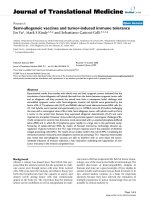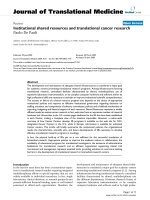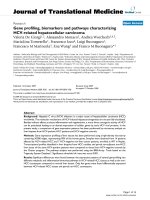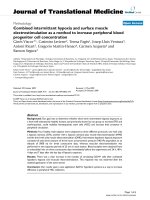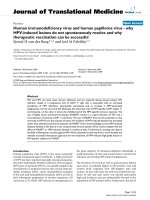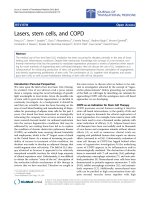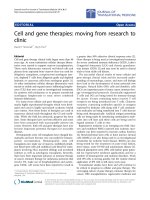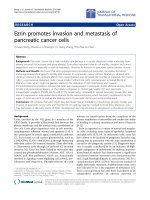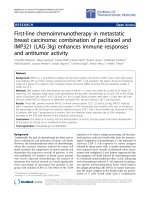Báo cáo hóa học: " Cellulose fibres, nanofibrils and microfibrils: The morphological sequence of MFC components from a plant physiology and fibre technology point of view" pptx
Bạn đang xem bản rút gọn của tài liệu. Xem và tải ngay bản đầy đủ của tài liệu tại đây (2.39 MB, 7 trang )
NANO REVIEW Open Access
Cellulose fibres, nanofibrils and microfibrils: The
morphological sequence of MFC components
from a plant physiology and fibre technology
point of view
Gary Chinga-Carrasco
Abstract
During the last decade, major efforts have been made to devel op adequate and commercially viable processes for
disintegrating cellulose fibres into their structural components. Homogenisation of cellulose fibres has been one of
the principal applied procedures. Homogenisation has produced mate rials which may be inhomogeneous,
containing fibres, fibres fragments, fibrillar fines and nanofibrils. The material has been denominated microfibrillated
cellulose (MFC). In addition, terms relating to the nano-scale have been given to the MFC material. Several modern
and high-tech nano-applications have been envisaged for MFC. However, is MFC a nano-structure? It is concluded
that MFC materials may be composed of (1) nanofibrils, (2) fibrillar fines, (3) fibre fragments and (4) fibres. This
implies that MFC is not necessarily synonymous with nanofibrils, microfibrils or any other cellulose nano-structure.
However, properly produced MFC materials contain nano-structures as a main component, i.e. nanofibrils.
Review
Introduction
Wood pulp fibres are presently a major area of research
for several end-use applications. Fibres can be utilised as
reinforcement in bio-degradable composites and as a
source of raw materials for bio-energy and biochemical
production. Wood pulp fibres have been applied as the
raw material for the production of a fibrillated material,
which was introduced and defined as microfibrillated
cellulose (MFC) by Turbak et al. [1] and Herrick et al.
[2]. Several modern and high-tech nano-applications
have been envisaged for MFC [1]. Although cellulose
fibres have constituted the main source for MFC pro-
duction, the utilisation of other pulp fibres, agricultural
cropsandby-productshavealsobeenexplored[3-5].
With the years, various subjective definitions have been
given to the fibrillat ed materials, e.g. nanofibrillated cel-
lulose, nanofibres, nanofibrils, microfib rils and nanocel-
lulose [6-10].
The German philosopher Immanuel Kant (1724 to
1804) wrote: “Thin gs which we see are not by them-
selves what we see It remains completely unknown to
us what the objects may be by themselves and apart
from the receptivity of our senses. We know nothing
but our manner of perceiving them ” . Perception is
thus a key word with respect to how we subjectively
interpret structures. This is clearly exemplified in the
relatively large number of terms that have been applied
to roughly the same material, and emphasises the neces-
sity of objectively clarifying and standardising the termi-
nology applied within cellulose nanotechnology
research. All the given terms relate to structures with
nano-dimensions. However, is MFC a nano-structure?
The purpose of this review is thus to shed more light
on (1) the morphology of MFC structures, (2) the rela-
tionship between biological components of fibre wall
structures and engineered cellulose-based nano-materi-
als and (3) the terms asso ciated with the MFC denomi-
nation. This review will not include other forms of
cellulose materials, such as whiskers or bacterial cellu-
lose, which may also be referred to as nanocellulose. For
interested readers, see Klemm et al. [5].
Correspondence:
Paper and Fibre Research Institute (PFI AS), Høgskolerringen 6b, 7491
Trondheim, Norway
Chinga-Carrasco Nanoscale Research Letters 2011, 6:417
/>© 2011 Chinga-Carrasco; licensee Springer. This is an Open Access article distributed under the terms of the Creative Commons
Attribution License (htt p://creativecommons.org/licenses/by/2.0), which permits unrestricted use, distribution, and reproduction in
any medium, provided the original work is properly cited.
The structure of wood pulp fibres
The wood pulp fibres have multiscale characteristics
[11]. Roughly, typical lengths of fibres are 1 to 3 mm
and typical widths are 10 to 50 μm. The fibre wall thick-
ness is roughly between 1 and 5 μm(Figure1).The
fibre wall is composed of defined layers (Figure 1b),
including the primary wall (P) and several secondary
wall layers (S1, S2 and S3). Each of these layers is
characterised by a specific arrangement of fibrils as has
been detailed described for more than 40 years ago [12].
Chemical pulp fibres are produced through che mical
pulping where lignin and hemicellulose are extracted.
Chemical pulp fibres have a surface, which is charac-
terised by a particular pattern created by wrinkles and
microfibrils in the outer layers of the fibre wall structure
(Figure 1a). The surface structure of chemical pulp
Figure 1 Structure of wood pulp fibres.(a) Note the network of microfibrils covering the outer wall layer. ( b) Microtomed cross section
showing the S1, S2 and S3 layers. (c) Cross-sectional fracture area, showing the microfibrils in the S2 layer. Reproduced and modified from
Chinga-Carrasco [11].
Chinga-Carrasco Nanoscale Research Letters 2011, 6:417
/>Page 2 of 7
fibres corresponds mainly to the primary and S1 layers
of the fibre wall, which are preserved during chemical
pulping. Contrary to the outer layers of the fibre wall
(primary and S1 layers), the S2 layer is characterised by
having a structure of microfibrils organised in a helical
manner [12].
According to Meier [13], the cellulosic components
of a wood fibre wall structure are the cellulose mole-
cule, the elementary fibril, the microfibril, the macrofi-
bril and the lamellar membrane. In the work of Maier
[13], the term “ele mentary fibril” was reported to have
a diameter of 3.5 nm and w as applied following the
terminology of Frey-Wyssling [14]. Heyn [12] stated
that elementary fibrils are universal structural units of
natural cellulose, as the same biological structure had
been encountered in cotton, ramie, jute and wood
fibres. Blackwell and Kolpak [15] reported also the
occurrence of elementary fibrils with diameters of
approximately 3.5 nm in cotton a nd bacterial cellulose,
thus giving supportive evidence about the basic fibrillar
unit in cellulose microfibrils, see also [16]. According
to Meier [13], microfibrils are agglomerates of elemen-
tary fibrils and always have diameters which are multi-
ples of 3.5 nm (Figures 1c and 2). The bundling of
elementary fibrils into microfibrils is caused by purely
physically conditioned coalescence as a mechanism of
reducing the free energy of the surfaces [17]. The max-
imum diameter of a microfibril was proposed to be 35
nm [13]. Clearly, there has been a debate during the
1950 to 1960s about the terminology applied for
describing the elementary components of a plant cell
wall.OhadandDanon[18]appliedthemicrofibril
term to the basic plant cell wall structures h aving a
diameter of 3.5 nm, i.e. the elementary fibrils
[12,14,19,20]. The microfibril structures reported by
Frey-Wyssling [14] were defined as “composite fibres”
by Ohad and Danon [18].
Ele mentary fibrils are generated in complex biol ogical
processes, involving cellulose synthase compl exes in the
plasma membrane, exocytosis of cell wall polymers and
cortical microtubules [21]. It seems to exist sufficient
evidences that elementary fibrils in vascular plant cell
walls are compo sed of 36 b-1,4-glucan chains, synthe-
sised by the cellulose synthase proteins in the plasma
membrane (rosette complexes) [22,23].
Microfibrillated cellulose
Since the introduction of the transmission electron
micro scope, it seems that researchers have attempted to
disintegrate cellulose fibres into single microfibrils/ele-
mentar y fibrils for ultrastructural studies. Already in the
1950s, ultrasonic, hydrolysis and oxidation treatments
were applied for disintegrating cellulose structures
[14,17,24]. In addition, Ross Colvin and Sowden [25]
reported a ho mogenization process based on beating for
opening the structure of cellulose fibres and thus expos-
ing the microfibril structuresfortransmission electron
microscopy (TEM) analysis.
The disintegration of cellulose fibres into their struc-
tural components (microfibrils) has also found industrial
interest. As mentioned above, in 1983, Turbak et al. [1]
introduced a homogenisation procedure for fibrillating
cellulose fibres with commercial purposes. The MFC
terminology, which was originally applied to the fibril-
lated material, was probably related to the predominant
structures encountered in fibre wall structures, i.e.
microfibrils [9].
Although microfibrils seem to be the main component
of MFC, several studies have shown that fibrillation pro-
duces a material which may be inhomogeneous
[2,16,26,27], containing , e.g. fibres, fibre fragments, fines
and fibrils (Figures 3, 4 and 5). As exemplified in Figure
3, the fraction of each component depends on (1) the
treatment applied to the fibres before homogenization,
(2) the number of passes through the homogenizer and
(3) the pressure applied during homogenization. The
more severe the homogenisation, the more fibrillated is
the material. Higher degree of fibrillation can be indi-
cated by an increase in the transparencies of the MFC
materials due to the generation of optically inactive
fibrils. Such fib rils form dense and compact structures,
with low light scattering potential.
Figure 2 Microfibril of Pinus radiata.ImageacquiredwithTEM.
The black arrow indicates the boundaries of a microfibril, which is
approximately 28 nm in diameter. The white arrows indicate a
single elementary fibril, which is 3.5 nm in diameter. See also
Chinga-Carrasco et al. [16].
Chinga-Carrasco Nanoscale Research Letters 2011, 6:417
/>Page 3 of 7
Having fibrillated materials w ith different degree of
homogenisation and composed of a variety of structures
emphasises the necessity of clarifying the different com-
ponents encountered in MFC. Table 1 gives a rough
classification of MFC components, including classical
terminology that has been applied in plant physiology
for decades and terminology related to fibre technology.
The fibril term has been applied for defining struc-
tures with a dimension less than 1 μm, although not
consequently. Structures with diameters of <1.0 μm
have also been observed in the fibre wall structure of
pulp fibres. Such structures have been denominated
macrofibrils, and diameters of approximately 0.66 μm
have been reported [28]. However, according to Meier
[13], macrofibrils do not havedefinitedimensions.A
fibril may also be considered an engineered structure as
it is produced during mechanical fibrillation. There
seems to be n o concrete border line between fibrils and
fibrillar fines (Figure 5A). Fibrillar fines may also be cre-
ated through refining or beating, from mechanical and
chemical pulp fibres, respectively [29]. Subramanian et
al. [30] considered fibrillar fines, microfines and microfi-
brillar cellulose in the same category, i.e. particles that
pass a 75-μm diameter round hole or a 200-mesh screen
of a fibre length classifier. Such a definition indicates
that MFC may also be considered as fines, as exempli-
fied in Figure 5A. Both materials are composed of rela-
tively small and fibrillated components. However,
according to Turbak et al. [1], no amount of conven-
tional beating yields the microfibrillation obtained with
an optimally homogenised product.
The microfibrillation mentioned by Turbak et al. [1]
does not seem to refer to the creation of m icrometre-
sized particles but to the fibrillation of fibres into indi-
vidualised microfibrils with diameters less than 100 nm
[1]. In this context, it is appropriate to introduce in
this review a sc ale that has been widely emphasised
during the last years within modern technology, i.e.
“ nano” . It seems to be widely a ccepted that a nano-
scale refers to sizes between 0.001 and 0.1 μm(1to
Figure 3 Films made of cellulose materials with a grammage of 20 g/m
2
.(A) Control film made of 100% P. r adiata pulp fibres. (B)Film
made of MFC, homogenised with three passes and 1,000 bar pressure. (C) Film made of MFC, homogenised with five passes and 1,000 bar
pressure. (D) Film made of MFC produced with TEMPO-pre-treated fibres, three passes and 200 bar pressure. (E) Film made of MFC produced
with TEMPO-pre-treated fibres, three passes and 600 bar pressure. (D) Film made of MFC produced with TEMPO-pre-treated fibres, five passes
and 1,000 bar pressure. Dark threadlike structures indicate poorly fibrillated fibres or fibre fragments. The lighter the local areas, the higher the
transparency levels. For details, see Syverud et al. [35].
Chinga-Carrasco Nanoscale Research Letters 2011, 6:417
/>Page 4 of 7
100 nm). This implies that the nanofibril term refers to
fibrils with diameters less than 100 nm. Based on this
definition, it seems obvious that microfibrils can be
considered nanofibrils, which also are composed of
crystalline and amorphous regions. However, the dif-
ference between microfibrils and nanofibrils is that the
former is a well-defined biological structure found in
plant cell walls, whereas the latter can be considered a
technological term introduced to describe secondary
and engineered structures with diameters less than
100 nm.
As mentioned above, conventional MFC production
yields materials with inhomogeneous sizes (Figures 3B,
C, 4A and 5A). However, the fibrillation can be facili-
tated by, e.g. pre-treating the cellulose fibres en zymati-
cally [31] or chemically [32,33]. Pre-treatments have
thus facilitated the production of homogeneous fibril
qualities, with fibril diameters less than 100 nm (Figure
3E,F). In addition, some authors have reported a filtra-
tion procedure to remove poorly fibrillated fibres, thus
maintaining mostly the fraction of homogeneous nanofi-
brils [34].
Figure 4 Surfaces of films (20 g/m
2
) made of microfibrillated cellulose.(A) MFC obtained by mechanical homogenisation. The image
corresponds to the film shown in Figure 3C. (B) MFC obtained with TEMPO-mediated oxidation as pre-treatment and mechanical
homogenisation. The image corresponds to the film shown in Figure 3F. The insets in (A) and (B) represent the surface structure visualised at
50,000× magnification from areas without a metallic coating. Both MFC materials have been collected after passing five times through the
homogeniser, at 1,000 bar. For details, see Chinga-Carrasco et al. [16].
Figure 5 Microfibrillated cellulose suspensions dried on glass slides.(A) MFC obtained by mechanical homogenisation. Note the relatively
large structures remaining after a homogenisation process. The inset shows structures composed mainly of nanofibrils. (B) MFC obtained with
TEMPO-mediated oxidation as pre-treatment and mechanical homogenisation. The inset shows the nanofibrils having relatively homogeneous
sizes. Both MFC materials (A and B) have been collected after passing five times through the homogeniser, at 1,000 bar.
Chinga-Carrasco Nanoscale Research Letters 2011, 6:417
/>Page 5 of 7
In general terms, th e production of homogeneous
fibril qualities may require major costs, including costs
related to pre-treatments and to energy consumption
during production. The less energy that is utilised, the
less is the fibrillation of cel lulose fibres and the less the
amount of produced nanofibrils [35]. Considering that
conventional fibrillation (e.g. homogenisation without
pre-treatment) produces a material that is inhomoge-
neous and may contain a major fraction of poorly fibril-
lated fibres and fines, can we state that MFC is a nano-
structure? MFC per se is not necessarily a nano-material,
but contains nano-structures, i.e. the nanofibrils (Figures
4 and 5). To define MFC as a nano-structure, it is
necessary to give substantial evidence with respect to (1)
the fraction of fibrillated fibres, (2) the fraction of nano-
fibrils and (3) the morphology of the nanofibrils in an
MFC material. Provided that a given MFC is composed
of an appropriate fraction of individualised nanofibrils,
the MFC will have a major influence on the rheological,
optical, mechanical and barrier properties of the corre-
sponding materials.
Commonly, morphological evidences are given by
microscopy and subjective evaluations. Researchers may
focus on the visual isation of nano-structures, applying
equipment designed for nano-assessment, e.g. FESEM,
AFM and TEM. However, such equipment may limit the
field of view considerably, which also introduces a subjec-
tive pre-selection of small areas containing nano-struc-
tures. Proper characterisation requires the quantification
of the fibrillated material at several scales. This can include
methods for assessing large areas, with a suitable resolu-
tion. One important aspect is not only the quantification
of nanofibril morphology but also the quantification of
fibres that are poorly fibrillated (see, e.g. Figure 3). Meth-
ods for assessing relatively large areas and structures at
the micromet re scale are thus most valuable for comple-
menting specialised devices for nano-characterisation.
Conclusions
It has been considered most important to propose an
appropriate morphological sequence and definitions of
MFC components. Microfibrils are important fibre wall
components, i.e. biological nano-structures. However,
due to the classical suffix “micro”, microfibrils may be
wrongly associated with micrometre-sized fibrils, which
may be 1,000 times larger (>1 μm). According to evi-
dences given in the literature and personal experience
with characterisation of a variety of MFC qualities, it
appears that MFC materials may be composed of (1)
nanofibrils, (2) fibrillar fines, (3) fibre fragments and (4)
fibres. This implies that MFC is not necessarily synon-
ymous with microfibrils, nanofibrils or any other cellu-
lose nano-structure. However , properly pro duced MFC
materials contain nano-structures as a main component,
i.e. nanofibrils.
Abbreviations
MFC: microfibrillated cellulose; TEM: transmission electron microscopy;
FESEM: field emission scanning electron microscopy; AFM: atomic force
microscopy.
Acknowledgements
All the images have been acquired by the author of this review, except
Figure 2 which was acquired with the skilful cooperation of Yingda Yu
(NTNU). Kristin Syverud (PFI) is acknowledged for valuable discussions and
Philip André Reme (PFI) for revising the original manuscript.
Competing interests
The author declares that he has no competing interests.
Received: 8 March 2011 Accepted: 13 June 2011
Published: 13 June 2011
References
1. Turbak AF, Snyder FW, Sandberg KR: Microfibrillated cellulose, a new
cellulose product: properties, uses, and commercial potential. J Appl
Polym Sci Appl Polym Symp 1983, 37:815-827.
2. Herrick FW, Casebier RL, Hamilton JK, Sandberg KR: Microfibrillated
Cellulose: Morphology and accessibility. J Appl Polym Sci Appl Polym Symp
1983, 37:797-813.
3. Siró I, Plackett D: Microfibrillated cellulose and new nanocomposite
materials: a review. Cellulose 2010, 17(3):459-494.
4. Spence KL, Venditti RA, Habibi Y, Rojas OJ, Pawlak JJ: The effect of
chemical composition on microfibrillar cellulose films from wood pulps:
mechanical processing and physical properties. Bioresource technology
2010, 101(15):5961-5968.
5. Klemm D, Kramer F, Moritz S, Lindström T, Ankerfors M, Gray D, Dorris A:
Nanocelluloses: A New Family of Nature-Based Materials. Angewandte
Chemie Int Ed 50.
6. Abe K, Iwamoto S, Yano H: Obtaining cellulose nanofibers with a uniform
width of 15 nm from wood. Biomacromolecules 2007, 8(10):3276-3278.
7. Gardner DJ, Oporto GS, Mills R, Samir MASA: Adhesion and surface issues
in cellulose and nanocellulose. J Adhesion Sci Techn 2008, 22:545-567.
8. Ahola S, Österberg M, Laine J: Cellulose nanofibrils–adsorption with poly
(amideamine) epichlorohydrin studied by QCM-D and application as a
paper strength additive. Cellulose 2008, 15(2):303-314.
9. Mörseburg K, Chinga-Carrasco G: Assessing the combined benefits of clay
and nanofibrillated cellulose in layered TMP-based sheets. Cellulose 2009,
16(5):795-806.
10. Siqueira G, Bras J, Dufresne A: Cellulose Whiskers versus Microfibrils:
Influence of the Nature of the Nanoparticle and its Surface
Functionalization on the Thermal and Mechanical Properties of
Nanocomposites. Biomacromolecules 2009, 10(2):425-432.
11. Chinga-Carrasco G: Microscopy and computerised image analysis of
cellulose fibres multiscale structures. In Microscopy: Science, Technology,
Applications and Education. Microscopy Book Series. Edited by: Méndez-Vilas
Table 1 Components of microfibrillated cellulose
Diameter
(μm)
Biological structures Technological terms
10 to 50 Tracheid Cellulose fibre
<1 Macrofibrils [13,17,28] Fibrillar fines, fibrils [29,30]
<0.1 Nanofibril, nanofibres
[6,8,16,34]
<0.035 Microfibril [13,15]
0.0035 Elementary fibril
[12-15]
Terms and sizes according to terminology and morphology reported in the
literature.
Chinga-Carrasco Nanoscale Research Letters 2011, 6:417
/>Page 6 of 7
A, Díaz J. Badajoz: Formatex Research Center, Badajoz, Spain;
2011:2182-2189.
12. Heyn AN: The elementary fibril and supermolecular structure of cellulose
in soft wood fiber. J Ultrastructure research 1969, 26:52-68.
13. Meier H: Chemical and morphological aspects of the fine structure of
wood. Pure and applied chemistry 1962, 5:37-52.
14. Frey-Wyssling A: The fine structure of cellulose microfibrils. Science 1954,
119:80-82.
15. Blackwell J, Kolpak FJ: The cellulose microfibril as an imperfect array of
elementary fibrils. Macromolecules 1975, 8(3):322-326.
16. Chinga-Carrasco G, Yu Y, Diserud O: Quantitative electron microscopy of
cellulose nanofibril structures from Eucalyptus and Pinus radiata kraft
pulp fibres. Microscopy and microanalysis 2011.
17. Peterlin A, Ingram P: Morphology of Secondary Wall Fibrils in Cotton.
Textile Res J 1970, 40(4):345-354.
18. Ohad I, Danon D: On the dimensions of cellulose microfibrils. J Cell Biol
1964, 22(1):302-305.
19. Moor H: Platin-Kohle-Abdruck-Technik angewandt auf den Feinbau der
Milcröhren. J Ultrastructure Res 1959, 2:393-422.
20. Frey-Wyssling A, Mühlethaler K: Die elementarfibrillen der cellulose.
Makromol Chem 1963, 62(1):25-31.
21. Lindeboom J, Mulder BM, Vos JW, Ketelaar T, Emons AMC: Cellulose
microfibril deposition: coordinated activity at the plant plasma
membrane. J Microscopy 2008, 231(2):192-200.
22. Somerville C: Cellulose Synthesis in Higher Plants. Annu Rev Cell Dev Biol
2006, 22:53-78.
23. Mutwil M, Debolt S, Persson S: Cellulose synthesis: a complex complex.
Curr Opin Plant biol 2008, 11(3):252-257.
24. Morehead F: Ultrasonic disintegration of cellulose fibres before and after
acid hydrolysis. Textile Res J 1950, 20(8):549-553.
25. Ross Colvin J, Sowden LC: The three-dimensional morphology of
aggregates of native cotton cellulose microfibrils. Int J Biol Macromol
1985, 7(4):214-218.
26. Plackett D, Anturi H, Hedenqvist M, Ankerfors M, Gällstedt M, Lindström T,
Siró I: Physical properties and morphology of films prepared from
microfibrillated cellulose and microfibrillated cellulose in combination
with amylopectin. J Applied Pol Sci 2010, 117(6):3601-3609.
27. Siró I, Plackett D, Hedenqvist M, Ankerfors M, Lindström T: Highly
transparent films from carboxymethylated microfibrillated cellulose: The
effect of multiple homogenization steps on key properties. J Applied Pol
Sci 2011, 119(5):2652-2660.
28. Paiva AT, Sequeira SM, Evtuguin DV, Kholkin AL, Portugal I: Nanoscale
structure of cellulosic materials: challenges and opportunities for AFM.
In Modern Research and Educational Topics in Microscopy. Edited by:
Méndez-Vilas A, Díaz J. Badajoz: Formatex Research Center, Badajoz, Spain;
2007:726-733.
29. Luukko K, Maloney TC: Swelling of Mechanical Pulp Fines. Cellulose 1999,
6(2):123-136.
30. Subramanian R, Fordsmand H, Paltakari J, Paulopuro H: A new composite
fine paper with high filler loading and functional cellulosic microfines. J
Pulp Paper Sci 2008, 34(3):146-152.
31. Pääkkö M, Ankefors M, Kosonen H, Nykänen A, Ahola S, Österberg M,
Ruokolainen J, Laine J, Larsson PT, Ikkala O, Lindström T: Enzymatic
hydrolysis combined with mechanical shearing and high-pressure
homogenization for nanoscale cellulose fibrils and strong gels.
Biomacromolecules 2007, 8(6):1934-1941.
32. Saito T, Nishiyama Y, Putaux JL, Vignon M, Isogai A: Homogeneous
Suspensions of Individualized Microfibrils from TEMPO-Catalyzed
Oxidation of Native Cellulose. Biomacromolecules 2006, 7(6):1687-1691.
33. Wågberg L, Decher G, Norgren M, Lindström T, Ankerfors M, Axnas K: The
Build-Up of Polyelectrolyte Multilayers of Microfibrillated Cellulose and
Cationic Polyelectrolytes. Langmuir 2008, 24(3):784-795.
34. Fukuzumi H, Saito T, Iwata T, Kumamoto Y, Isogai A: Transparent and high
gas barrier films of cellulose nanofibers prepared by TEMPO-mediated
oxidation. Biomacromolecules 2009, 10(1):162-165.
35. Syverud K, Chinga-Carrasco G, Toledo J, Toledo P: A comparative study of
Eucalyptus and Pinus radiata pulp fibres as raw materials for production
of cellulose nanofibrils. Carbohydrate Polymers 2010, 84(3):1033-1038.
doi:10.1186/1556-276X-6-417
Cite this article as: Chinga-Carrasco: Cellulose fibres, nanofibrils and
microfibrils: The morphological sequence of MFC components from a
plant physiology and fibre technology point of view. Nanoscale Research
Letters 2011 6:417.
Submit your manuscript to a
journal and benefi t from:
7 Convenient online submission
7 Rigorous peer review
7 Immediate publication on acceptance
7 Open access: articles freely available online
7 High visibility within the fi eld
7 Retaining the copyright to your article
Submit your next manuscript at 7 springeropen.com
Chinga-Carrasco Nanoscale Research Letters 2011, 6:417
/>Page 7 of 7
